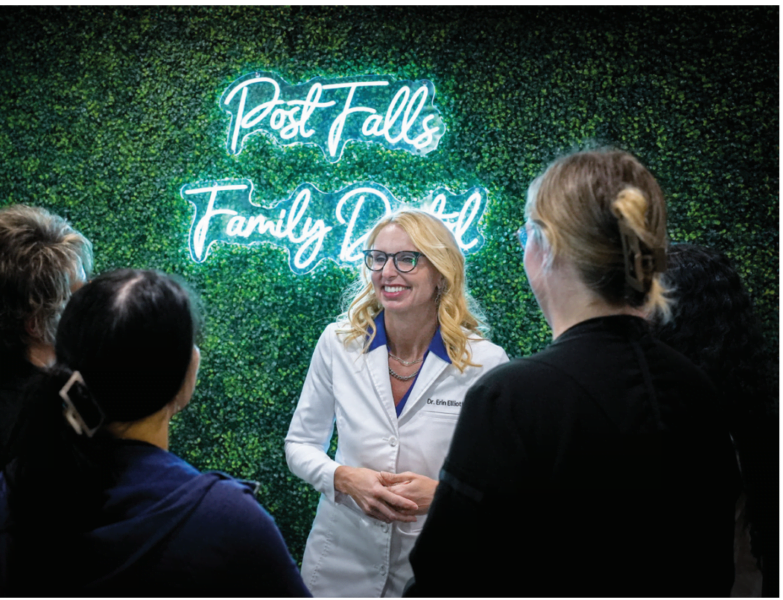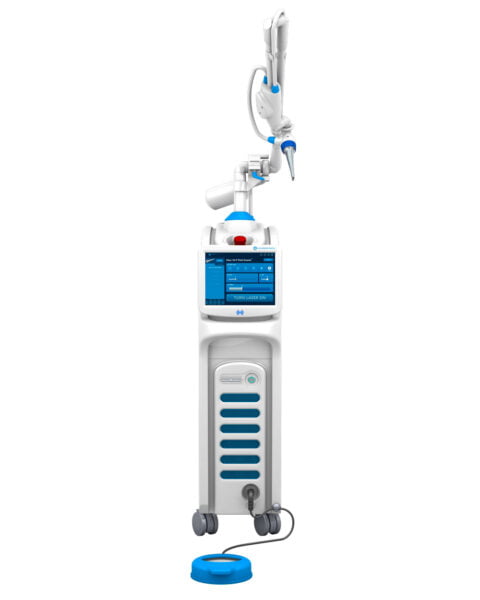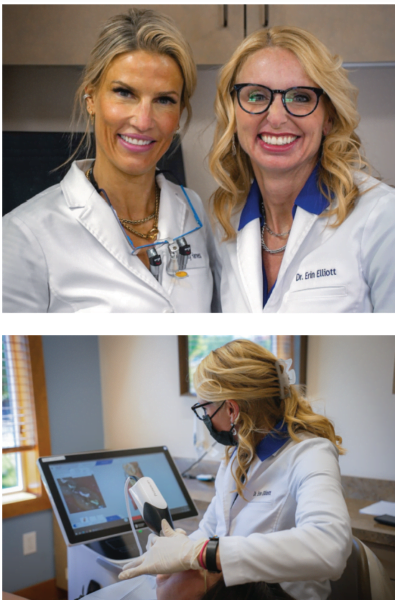Dr. Erin Elliott’s dental sleep-medicine practice has benefitted from Solea Sleep and its versatility to treatment of sleep-breathing issues.
 by Erin Elliott, DDS, DASBA
by Erin Elliott, DDS, DASBA
From an early age, I was certain my future lay in medicine. I had my sights set on being a trauma surgeon, but when I thought more about work-life-balance, dentistry emerged as a natural choice, influenced by my father, who was also a dentist.
Creighton University School of Dentistry opened my eyes to the breadth of what dentistry entailed by offering substantial hands-on experience, allowing me to perform a variety of treatments and specialty work, but at the time, no sleep medicine.
When I first started practicing, my perception of dentistry was conventional – I was a “drill and fill” dentist, handling routine dental care and referring out more complex cases. My perspective changed dramatically in 2008 at the Idaho State Dental Convention. I attended a session where a sleep physician spoke in the morning and a dentist specializing in sleep and TMJ disorders presented in the afternoon. This was a revelation. I love to sleep, always go to bed early, and am always the first to leave a party. I was fascinated by the potential to merge my personal love of sleeping with my professional life. Despite the early state of the field at the time and the skepticism it faced, I decided to delve into dental sleep medicine.

Overcoming Initial Challenges
Implementing dental sleep medicine into my practice was not without challenges. Initially, I struggled to integrate my team into this new focus, mistakenly trying to handle everything on my own. Our practice consultant even doubted the viability of incorporating sleep medicine. I wasn’t always sure this plane would take off, but I was determined.
Initially, medical insurance denials were a significant hurdle. When dentists encounter such rejections, it can be discouraging, leading some to prematurely conclude that dental sleep medicine is not feasible. My approach was relentless – I refused to give up and was committed to finding solutions. Navigating the complexities of medical billing has become much easier, not just because our practice knows more, but insurance companies are understanding the benefits, too.
Patient denial is still a hurdle. Many patients tend to dismiss the severity of their condition, sometimes putting up defensive walls. In such cases, I learned to plant a seed of awareness and move on, understanding that persistence and patience are key.
One of my earliest and most impactful cases was my own father. He exhibited numerous signs of sleep apnea – snoring, bruxism, a retrognathic profile, acid reflux, and a sensitive gag reflex – but never thought much about it. The results of a sleep test were alarming; he had moderate to severe sleep apnea, with his heart working excessively hard during what should have been restful sleep. An oral appliance had an immediate and profound effect. His snoring ceased, his heart rate stabilized, and my mother’s insomnia improved as a result. Witnessing such a transformative impact on my own family reinforced my commitment to dental sleep medicine.

Discovering a Game-Changer for Snoring
My journey into Solea® Sleep (an application on the Solea® All-Tissue Laser by Convergent Dental) began out of necessity. I was encountering patients with severely compromised airways who, despite using dental appliances, continued to snore. Traditional treatments like surgery were not ideal due to their low success rates, high costs, and painful recoveries. I knew we needed a non-invasive solution to effectively address these issues.
Solea Sleep stood out for its ability to tighten and shrink airway tissue, reducing snoring by making the tissue healthier and less collapsible. As a general dentist, I was also drawn to Solea’s versatility for both hard and soft tissue applications. Solea is known for reliably anesthesia-free, pain-free restorations that enables more same-day, multi-quadrant dentistry. And unlike diode lasers, which often char and smell unpleasant, Solea offers a virtually blood-free, cleaner, more effective solution for soft tissue. This was particularly appealing for procedures like crown lengthening and subgingival work, which we perform frequently in our busy practice. Solea is also ideal for releasing tethered oral tissues.
My previous attempts at tongue tie releases with a diode laser had been unsatisfactory. The Solea training we received from Anthony Bolamperti, DDS, a former Creighton University instructor of mine, revolutionized our approach to these procedures. The results were immediate and impressive, with minimal bleeding and quicker healing, significantly benefiting our pediatric and adult patients and their airway health.
Our practice has seen a surge in demand for these services, driven by increasing patient awareness about the benefits of nasal breathing and the impact of tongue ties on overall health. This shift is in stark contrast to the early days when discussions about tongue ties often met with indifference or outright shock that I would suggest such a thing, as there was not a lot of information available to the benefits and impact.
One of the most rewarding aspects of using Solea Sleep specifically is the lack of post-operative pain and complications. Unlike other surgical interventions, patients experience minimal discomfort and we avoid the usual barrage of post-op calls. This not only enhances patient satisfaction but also strengthens the bond we build with them throughout their treatment journey.
I had a patient whose airway tissue was damaged after years of snoring, resulting in persistent noise even with the appliance functioning at its maximum clinical efficacy for sleep apnea. His compromised tissue continued to vibrate until we deployed Solea Sleep: we tightened and stiffened the tissue in his soft palate which solved his snoring problem! The added benefit? He reported significantly improved breathing during the day as well.
Both Solea and Solea Sleep have integrated seamlessly into our practice, improving patient outcomes, and expanding our ability to address complex airway issues comprehensively.

Every Dental Sleep Patient is Unique
Understanding that each patient is unique is crucial. I focus on their individual stories and needs. While oral appliances can be highly effective, I recognize that a multifaceted approach is often necessary.
A critical step in our process is always conducting a sleep study before treatment. During exams, I look for anatomical signs and symptoms indicative of airway problems, such as a swollen uvula or excessive soft tissue. For patients with poor tissue quality, we combine Solea Sleep with dental appliances to provide a comprehensive solution. By setting realistic expectations, we ensure patients understand that while appliances can manage nighttime airway issues, Solea Sleep can be essential for long-term tissue health. Starting with simple, cost-effective solutions and gradually exploring other treatments ensures personalized care and better outcomes.
I actively engage with my community to spread awareness, leveraging personal connections with local physicians, trainers, nutritionists, and optometrists. My husband often remarks that he can tell the difference between my dental and sleep patients when we are out in our small community. Dental patients will usually greet me warmly, but sleep patients go a step further – they introduce me to their families exclaiming, “This woman saved my life!”
A patient’s sister died from sleep apnea, which had caused her heart to enlarge. Motivated by her sister’s death, she lost ninety-eight pounds and kept it off, but her CPAP machine was not effective. She turned to us and, with an appliance, finally felt rested and stopped snoring. This story underscores the importance of offering alternative treatments for those who struggle with traditional methods.
We often help overlooked patients who don’t fit the typical profile of sleep-disordered breathing, like women with chronic insomnia and fatigue, often dismissed as stress or anxiety. Many of these women are given night guards that do not help, or even if they had a sleep study, were told they only had mild issues. I passionately advocate that chronic insomnia in women should be considered sleep-disordered breathing until proven otherwise.
One such case involved my partner, Kelly Harness, DMD. Despite being a “young, fit female,” she had upper airway resistance, considered herself a light sleeper, and regularly woke up to use the bathroom. After learning more about dental sleep medicine as I integrated it into the practice, she realized these were signs of deeper issues. She started using a ProSomnus EVO Select appliance with a discluding element for her clenching symptoms and now sleeps deeply, waking up refreshed and ready for the day.
Educating patients on how sleep issues affect more than just snoring – highlighting impacts on blood pressure, nocturnal bathroom visits, and overall health – helps them understand the urgency. The most fulfilling part of my job is witnessing the transformation when patients, initially skeptical or resistant, embrace the treatment and experience significant improvements in their quality of life.
In essence, my practice aims to provide individualized care, addressing the unique needs and concerns of each patient. Whether through appliances, Solea Sleep or other treatments, the goal is to help them achieve better health and well-being, making every effort and every story worth it.

Bottom: Dr. Elliott using Primescan
Advice for General Dentists Entering Dental Sleep Medicine
When considering dental sleep medicine, start with your “why.” If your primary goal is financial gain, rethink your motivation. Adding sleep medicine is not like adding a dental procedure such as implants; it requires a longer commitment and a different mindset. Success in this field demands persistence, especially when it seems like progress is slow.
Focus on the impact you can have on patients’ lives. Hearing from just one patient that you have changed their life can be incredibly motivating. Over time, patient referrals will grow organically, and your practice will thrive without extensive marketing. Remember, dental sleep medicine is about offering comprehensive care that extends beyond just teeth.
One of the most valuable resources in building my sleep medicine practice has been my mentor, Dr. Kent Smith. He is double board-certified by the American Board of Dental Sleep Medicine and the American Sleep & Breathing Academy (where he previously served as president) and is widely considered to be a pioneer in the field of dental sleep medicine. His guidance and education have allowed me to follow and thrive in our shared passion for dental sleep medicine. Where possible, find yourself a mentor to learn from their experience and lean on for advice.
I also have a close-knit group of dental sleep medicine colleagues, and we convene annually to discuss best practices, case challenges, and emerging trends. This mastermind group, similar to a study club, provides vital support and shared knowledge.
Additionally, the American Academy of Sleep Medicine and the American Academy of Dental Sleep Medicine offer essential guidance on medical insurance and practice standards. Staying updated with new research, case studies, and ongoing mentors-hip has been crucial in maintaining a successful and informed practice.
A Rewarding Journey in Sleep Medicine
This journey has been both challenging and rewarding. Integrating dental sleep medicine has allowed me to enhance my practice and provide comprehensive care that addresses both dental and overall health. It is a reminder that in the pursuit of excellence, staying open to new ideas and persistent in the face of obstacles can lead to transformative outcomes.
The path for dentists entering this field is now clearer, with better tools and more educated patients driving the demand for innovative treatments like Solea Sleep. My final message to dentists is threefold:
First, even if you do not want to treat patients or handle medical billing, at least screen for sleep breathing disorders and find a reliable referral partner. Do not leave these people without help!
Second, having the right technology is important for proper screening, effective treatment planning, and enhanced patient outcomes. Advanced tools like digital imaging, intraoral scanners, home sleep study machines, and Solea laser therapy streamline processes and improve quality of care.
Finally, remember that this journey requires patience – a long runway before the plane takes off. Do not give up too soon. The rewards, both personal and professional, are truly worth it.
Read more about Solea Sleep and how Dr. Anthony Bolamperti treats patients non-invasively with Solea lasers. https://dentalsleeppractice.com/wake-up-call/
 Erin Elliott, DDS, DASBA, left Southern California for Western New York to play collegiate soccer at Houghton College, where she graduated summa cum laude. After graduating from Creighton University School of Dental Medicine in the top five of her class, she began her general dentistry career in North Idaho. Dr. Elliott has a special interest in dental sleep medicine, which comprises a large part of her practice. She has lectured extensively on this topic and loves to help general dentists extend this lifesaving service to their patients. She is an active member of the Idaho State Dental Association, the American Academy of Sleep Medicine, American Academy of Dental Sleep Medicine, and is the past president and a diplomate of the American Sleep and Breathing Academy. In addition to speaking to study clubs and at dental meetings, Dr. Elliott teaches a two-day sleep apnea course at 3D Dentists in Raleigh, North Carolina, with Tarun Agarwal, DDS, as well as privately coaches practices about sleep medicine.
Erin Elliott, DDS, DASBA, left Southern California for Western New York to play collegiate soccer at Houghton College, where she graduated summa cum laude. After graduating from Creighton University School of Dental Medicine in the top five of her class, she began her general dentistry career in North Idaho. Dr. Elliott has a special interest in dental sleep medicine, which comprises a large part of her practice. She has lectured extensively on this topic and loves to help general dentists extend this lifesaving service to their patients. She is an active member of the Idaho State Dental Association, the American Academy of Sleep Medicine, American Academy of Dental Sleep Medicine, and is the past president and a diplomate of the American Sleep and Breathing Academy. In addition to speaking to study clubs and at dental meetings, Dr. Elliott teaches a two-day sleep apnea course at 3D Dentists in Raleigh, North Carolina, with Tarun Agarwal, DDS, as well as privately coaches practices about sleep medicine.